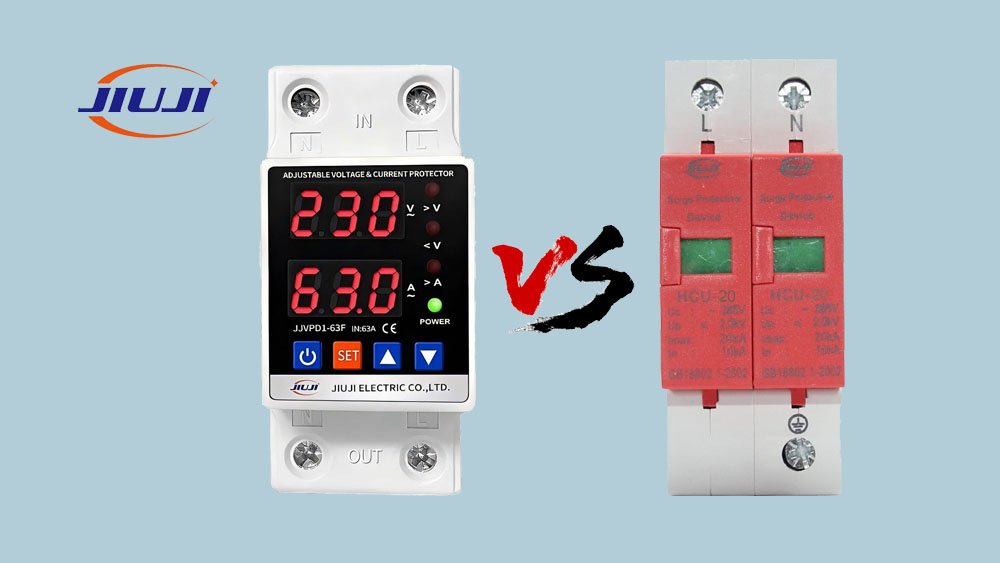Both Voltage Protectors and Surge Protectors are essential power protection devices, but they serve distinct roles in safeguarding electronic equipment. Jiuji Electric as a professional voltage protector manufacturer compares these two devices to help you understand their features, working principles, applications, and when to use them.
| Feature | Voltage Protector | Surge Protector |
|---|---|---|
| Definition | A device designed to monitor and regulate voltage levels, protecting equipment from both over-voltage and under-voltage by disconnecting power when necessary and restoring it once normal levels are reached. | A protective device that safeguards electrical systems by redirecting transient voltage surges to the ground, effectively absorbing the surge energy without interrupting the power supply. |
| Core Function | Monitors and regulates voltage to prevent damage from over-voltage and under-voltage. Disconnects power when voltage levels are unsafe and restores it once normal. | Diverts transient voltage surges to the ground to prevent equipment damage, without interrupting the power supply. |
| Working Principle | Through a microprocessor monitoring voltage fluctuations, it disconnects power when voltage exceeds or falls below preset safe limits. | Utilizes components like Metal Oxide Varistors (MOVs) or TVS diodes to divert excess voltage to the ground, allowing normal power flow when surges are not present. |
| Protection Mechanism | Disconnects the power supply during sustained voltage fluctuations. Restores the connection once voltage stabilizes. | Absorbs surge energy by redirecting it to the ground, protecting equipment from brief, high-energy spikes. |
| Protection Duration | Offers long-term protection against voltage irregularities, preventing gradual wear on sensitive equipment. | Provides short-term protection against brief voltage surges (such as from lightning or grid issues). |
2. Key Components
| Component | Voltage Protector | Surge Protector |
|---|---|---|
| Main Technology | Microprocessor-based system for voltage monitoring. | MOVs (Metal Oxide Varistors) or TVS diodes for surge absorption. |
| Function | Monitors voltage levels and disconnects the power when needed. | Redirects surge energy to the ground to protect devices. |
3. Application Scenarios
| Use Case | Voltage Protector | Surge Protector |
|---|---|---|
| For Consistent Voltage Fluctuations | Ideal for areas with frequent voltage drops or spikes. Protects devices like refrigerators, computers, and industrial machinery. | Surge protectors are not necessary for routine voltage fluctuations but are crucial for handling short-duration spikes. |
| For External Disturbances (e.g., Lightning) | Voltage protectors do not directly handle lightning strikes or brief surges. | Surge protectors are essential in areas prone to lightning or power grid issues. They absorb large surges from external disturbances. |
| For Sensitive Equipment | Protects equipment that requires stable voltage, such as computers, medical equipment, and industrial machinery. | Safeguards electronics vulnerable to brief high-voltage surges, such as televisions, audio equipment, and computers. |
4. Advantages of Each Device
| Advantage | Voltage Protector | Surge Protector |
|---|---|---|
| Protection Type | Provides long-term protection against sustained voltage irregularities. Ideal for areas with frequent voltage fluctuations. | Protects against brief, high-energy surges. Essential for areas prone to lightning or grid disturbances. |
| Handling Duration | Protects against gradual voltage fluctuations over time. | Absorbs short, high-energy voltage spikes in a split second. |
| Suitability | Ideal for regions where voltage regulation is a must for long-term equipment health. | Ideal for areas with occasional high-voltage surges from external sources. |
5. When to Use Each Device
| Condition | Voltage Protector | Surge Protector |
|---|---|---|
| For Consistent Voltage Fluctuations | When your region experiences frequent voltage drops or spikes, a voltage protector ensures steady operation of sensitive devices. | Surge protectors are not needed for routine fluctuations but critical for handling high-energy surges. |
| For External Disturbances (e.g., Lightning) | Voltage protectors do not directly handle lightning strikes or large surges. | Surge protectors are designed for handling lightning strikes or other external high-energy surges. |
| For Sensitive Equipment | Essential for devices requiring consistent, stable voltage, such as medical equipment, industrial machinery, and high-end computers. | Suitable for electronics vulnerable to sudden surges, like TVs, audio systems, and computers. |
Practical Use Cases
- Voltage Protector:
In a region with frequent voltage fluctuations, such as power grids that fluctuate between 190V and 250V, a voltage protector will protect your appliances (e.g., refrigerators, air conditioners, computers) from gradual damage caused by over- or under-voltage. - Surge Protector:
For areas with frequent lightning storms, a surge protector is vital. It will protect electronics (e.g., TVs, stereos, computers) by absorbing and redirecting high-energy surges from lightning, ensuring no damage to the devices.
6. Conclusion: Choosing the Right Protection
| Key Consideration | Voltage Protector | Surge Protector |
|---|---|---|
| Best for Consistent Protection | Best for areas with frequent voltage fluctuations that could cause long-term damage to sensitive devices. | Not suitable for consistent protection, but essential for handling short bursts of energy. |
| High-Energy Surge Protection | Not designed for handling high-energy surges (e.g., lightning strikes). | Specifically designed to absorb large, short-duration surges like those from lightning or grid malfunctions. |
Actionable Tips:
- For regions with frequent voltage fluctuations, install a Voltage Protector to prevent long-term damage to sensitive equipment.
- For areas prone to lightning or electrical surges, a Surge Protector is essential for protecting electronics.
7. FAQs (Frequently Asked Questions)
| Question | Answer |
|---|---|
| Q1: Can a surge protector replace a voltage protector? | No, they serve different purposes. Voltage protectors regulate long-term voltage stability, while surge protectors handle brief, high-energy surges. |
| Q2: How do I know which device I need? | If you face voltage fluctuations over time, choose a voltage protector. If lightning or other voltage spikes are a concern, go for a surge protector. |
| Q3: Can surge protectors handle high-energy surges? | Yes, they are specifically designed to handle high-energy surges, often in the range of thousands of volts, ensuring your equipment is protected during surges. |

